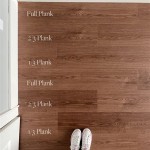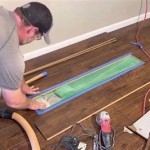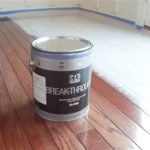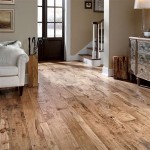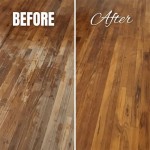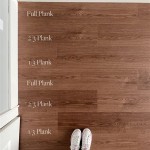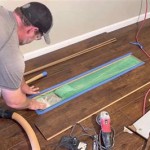How To Remove Sticky Substance From Wood Floor
Wood floors, known for their natural beauty and durability, are susceptible to accumulating sticky substances. These residues, often the result of spills, adhesives, or tracked-in materials, can detract from the floor's appearance and potentially damage the finish if left unattended. Removing these substances requires a careful approach to avoid harming the wood itself. This article provides a detailed guide on safely and effectively removing sticky substances from wood floors, outlining various methods and preventative measures.
The nature of the sticky substance will influence the optimal removal method. Identifying the substance is crucial for choosing the right solvent or cleaning agent. Common culprits include spilled food and beverages (especially those containing sugars), adhesives from tape or stickers, wax, gum, and various household products.
Before commencing any cleaning procedure, testing the chosen method on an inconspicuous area of the floor is paramount. This ensures that the cleaning agent does not discolor, damage, or strip the finish from the wood. A small corner of the room, perhaps hidden under furniture, serves as an ideal test location.
Identifying the Sticky Substance
Accurately identifying the sticky substance is the first step towards successful removal. If the spill is recent and its origin is known, the corresponding cleanup method can be immediately implemented. However, if the substance is unidentified, a process of elimination may be necessary. Observe the appearance, texture, and location of the residue. Consider recent activities in the area that might have caused the spill. For instance, if the sticky substance is near a crafting area, it might be glue or adhesive residue. If it's near a window, it could be sap or tree resin. If children are present, consider candy or other sugary substances. Observation combined with some deductive reasoning often leads to a correct identification, or at least narrows down the possibilities.
Consider these common sticky substances and their potential characteristics:
- Sugary Spills (Soda, Juice, Candy): These are often clear or colored, harden over time, and feel very sticky. They attract dirt and can be easily dissolved in water.
- Adhesives (Tape, Stickers, Glue): Appear as a thin, sometimes gummy or hardened layer. The removal method depends on the type of adhesive.
- Wax (Candles, Crayons): Solidifies upon cooling, leaving a waxy residue that can be scraped off.
- Gum: Chewy and pliable when fresh, hardening and becoming brittle over time.
- Oil-Based Substances (Cooking Oil, Grease): Leave a greasy residue that attracts and holds dirt.
Gentle Removal Methods for Fresh Residue
For fresh spills and sticky substances, initiating with the gentlest possible methods is always recommended. Aggressive scrubbing or harsh chemicals can easily damage the wood floor's finish. These methods often involve minimal intervention and readily available household items.
Warm Water and a Soft Cloth: This is often the first and most effective approach for removing recent spills. Dampen a soft, clean cloth with warm (not hot) water and gently blot the affected area. Avoid saturating the wood, as excessive moisture can lead to warping or other damage. Change the cloth frequently, using a clean portion for each blot. Continue blotting until the sticky residue is lifted. Afterwards, dry the area thoroughly with another clean, dry cloth.
Dish Soap Solution: If warm water alone is insufficient, adding a small amount of mild dish soap can aid in the removal process. Create a diluted solution of dish soap and warm water. Apply the solution to a soft cloth and gently blot the sticky area. Exercise caution to prevent excessive moisture. After blotting, rinse the area with a clean, damp cloth to remove any soap residue. Finally, dry the floor thoroughly with a clean, dry cloth.
Ice Pack: For sticky substances such as gum or hardened wax, applying an ice pack can help to solidify the residue, making it easier to remove. Place an ice pack wrapped in a clean cloth directly on the sticky area for several minutes. The cold temperature will cause the substance to harden and become brittle. Once hardened, gently scrape the substance away with a plastic scraper or spatula. Avoid using metal tools, as they can scratch the wood finish. Clean the area with a damp cloth and dry thoroughly.
Advanced Methods for Stubborn or Dried Residue
When gentle methods prove ineffective, more advanced techniques may be necessary. These methods often involve the use of solvents or specialized cleaning agents. Prior testing in an inconspicuous area remains essential before applying these methods to the entire affected surface.
Rubbing Alcohol (Isopropyl Alcohol): Rubbing alcohol is an effective solvent for dissolving many types of sticky residues, including adhesives, inks, and certain types of wax. Dampen a clean cloth with rubbing alcohol and gently blot the affected area. Avoid pouring alcohol directly onto the floor. Allow the alcohol to sit for a few seconds to dissolve the residue, then wipe away with a clean cloth. Repeat as needed. Ensure the area is well-ventilated to prevent the buildup of flammable vapors. After removing the residue, clean the area with a damp cloth and dry thoroughly.
Vinegar Solution: A diluted solution of white vinegar and water can be effective for removing certain types of sticky residue, particularly those caused by sugary spills. Mix equal parts white vinegar and warm water. Apply the solution to a clean cloth and gently blot the affected area. Avoid allowing the vinegar solution to sit on the floor for extended periods, as it can potentially damage the finish. After blotting, rinse the area with a clean, damp cloth and dry thoroughly.
Mineral Spirits: Mineral spirits are a stronger solvent that can be used to remove more stubborn residues, such as grease, oil, and some types of adhesives. Mineral spirits should be used with caution, as they can be flammable and may damage certain types of wood finishes. Before using mineral spirits, ensure the area is well-ventilated and wear appropriate protective gloves. Dampen a clean cloth with mineral spirits and gently blot the affected area. Allow the mineral spirits to sit for a few seconds to dissolve the residue, then wipe away with a clean cloth. After removing the residue, clean the area with a clean, damp cloth and dry thoroughly. Dispose of used cloths properly, as they may be flammable.
Commercial Adhesive Removers: Several commercial adhesive removers are specifically designed for removing sticky residues from surfaces, including wood floors. These products often contain solvents that dissolve the adhesive without damaging the underlying finish. Before using a commercial adhesive remover, carefully read and follow the manufacturer's instructions. Test the product in an inconspicuous area to ensure it does not damage the wood finish. Apply the adhesive remover to a clean cloth and gently blot the affected area. Allow the product to sit for the recommended amount of time, then wipe away with a clean cloth. Clean the area with a damp cloth and dry thoroughly.
Heat Gun (with extreme caution): A heat gun, used with extreme caution, can soften some adhesives and waxes, making them easier to scrape away.
This method carries a high risk of damaging the wood finish and should only be attempted by experienced individuals.
Keep the heat gun moving and avoid focusing the heat on one spot for too long. Use a plastic scraper to gently remove the softened residue. Start on the lowest setting and increase heat gradually. Test in an inconspicuous area first. Clean with a damp cloth and dry thoroughly. Due to the inherent risks, it is generally advisable to try other methods before resorting to a heat gun.After removing the sticky substance, it's crucial to clean the area thoroughly to remove any remaining residue or cleaning agents. Use a damp cloth to wipe down the area, followed by a dry cloth to ensure the floor is completely dry. For hardwood floors with a polyurethane finish, consider applying a small amount of wood floor cleaner to restore the shine and protect the finish.
Preventative maintenance is key to minimizing the occurrence of sticky substances on wood floors. Regular sweeping or vacuuming removes loose dirt and debris that can adhere to spills and contribute to sticky buildup. Promptly cleaning up spills minimizes the chance of residues hardening and becoming more difficult to remove. Using floor mats at entryways can trap dirt and debris before they are tracked onto the wood floor. Finally, consider applying a protective coating or sealant to the wood floor to enhance its resistance to stains and spills.

4 Ways To Remove Adhesive From A Hardwood Floor Wikihow

First Aid Remove Sticky Residue Simple Decorating Tips

How To Remove Glue From Wood Floors Pete S

How To Remove Sticky Residue From Hardwood Floors

4 Ways To Remove Adhesive From A Hardwood Floor Wikihow

First Aid Remove Sticky Residue Simple Decorating Tips

Removing Glue Or Adhesive From Hardwood Floors The Speckled Goat

4 Reasons Your Floors Are Sticky And How To Fix Them

Removing Glue Or Adhesive From Hardwood Floors The Speckled Goat

How To Remove Sticky Residue From Hardwood Floors
See Also

